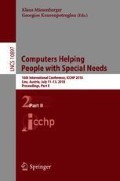Abstract
Over the past years, convolutional neural networks (CNN) have not only demonstrated impressive capabilities in computer vision but also created new possibilities of providing navigational assistance for people with visually impairment. In addition to obstacle avoidance and mobile localization, it is helpful for visually impaired people to perceive kinetic information of the surrounding. Road barrier, as a specific obstacle as well as a sign of entrance or exit, is an underlying hazard ubiquitously in daily environments. To address the road barrier recognition, this paper proposes a novel convolutional neural network named KrNet, which is able to execute scene classification on mobile devices in real time. The architecture of KrNet not only features depthwise separable convolution and channel shuffle operation to reduce computational cost and latency, but also takes advantage of Inception modules to maintain accuracy. Experimental results are presented to demonstrate qualified performance for the meaningful and useful applications of navigational assistance within residential and working area.
Access this chapter
Tax calculation will be finalised at checkout
Purchases are for personal use only
References
Bourne, R.R.A., Flaxman, S.R.: Magnitude, temporal trends, and projections of the global prevalence of blindness and distance and near vision impairment: a systematic review and meta-analysis. Lancet Glob. Health 5, e888–e897 (2017)
Krizhevsky, A., Sutskever, I., Hinton, G.E.: ImageNet classification with deep convolutional neural networks. In: Advances in Neural Information Processing Systems, pp. 1–9 (2012)
Shelhamer, E., Long, J., Darrell, T.: Fully convolutional networks for semantic segmentation. IEEE Trans. Pattern Anal. Mach. Intell. 39, 640–651 (2017)
Lin, J., Wang, W.J., Huang, S.K., Chen, H.C.: Learning based semantic segmentation for robot navigation in outdoor environment. In: 2017 Joint 17th World Congress of International Fuzzy Systems Association and 9th International Conference on Soft Computing and Intelligent Systems (IFSA-SCIS), pp. 1–5 (2017)
Arroyo, R., Alcantarilla, P.F., Bergasa, L.M., Romera, E.: Fusion and binarization of CNN features for robust topological localization across seasons. In: IEEE International Conference on Intelligent Robots and Systems, pp. 4656–4663 (2016)
Russakovsky, O., Deng, J., Su, H., Krause, J., Satheesh, S., Ma, S., Huang, Z., Karpathy, A., Khosla, A., Bernstein, M., Berg, A.C., Fei-Fei, L.: ImageNet large scale visual recognition challenge. Int. J. Comput. Vis. 115, 211–252 (2015)
Simonyan, K., Zisserman, A.: Very Deep Convolutional Networks for Large-Scale Image Recognition. ImageNet Challenge, pp. 1–10 (2014)
Szegedy, C., Liu, W., Jia, Y., Sermanet, P., Reed, S., Anguelov, D., Erhan, D., Vanhoucke, V., Rabinovich, A.: Going deeper with convolutions. In: Proceedings of the IEEE Computer Society Conference on Computer Vision and Pattern Recognition, 7-12-NaN-2015, pp. 1–9 (2015)
He, K., Zhang, X., Ren, S., Sun, J.: Deep residual learning for image recognition. In: 2016 IEEE Conference on Computer Vision and Pattern Recognition (CVPR), pp. 770–778 (2016)
Han, S., Mao, H., Dally, W.J.: A Deep Neural Network Compression Pipeline: Pruning, Quantization, Huffman Encoding. arXiv:1510.00149 [cs], p. 13 (2015)
Hinton, G., Vinyals, O., Dean, J.: Distilling the knowledge in a neural network. Comput. Sci. 1–9 (2015). https://arxiv.org/abs/1503.02531
Iandola, F.N., Moskewicz, M.W., Ashraf, K., Han, S., Dally, W.J., Keutzer, K.: SqueezeNet. arXiv, pp. 1–5 (2016)
Howard, A.G., Zhu, M., Chen, B., Kalenichenko, D., Wang, W., Weyand, T., Andreetto, M., Adam, H.: MobileNets: Efficient Convolutional Neural Networks for Mobile Vision Applications. arXiv, p. 9 (2017)
Zhang, X., Zhou, X., Lin, M., Sun, J.: ShuffleNet: An Extremely Efficient Convolutional Neural Network for Mobile Devices. arXiv, pp. 1–10 (2017)
Yang, K., Wang, K., Hu, W., Bai, J.: Expanding the detection of traversable area with RealSense for the visually impaired. Sensors 16, 1954 (2016)
Yang, K., Wang, K., Cheng, R., Hu, W., Huang, X., Bai, J.: Detecting traversable area and water hazards for the visually impaired with a pRGB-D sensor. Sensors 17, 1890 (2017)
Cheng, R., Wang, K., Yang, K., Long, N., Hu, W.: Crosswalk navigation for people with visual impairments on a wearable device. J. Electron. Imaging 26, 1 (2017)
Cheng, R., Wang, K., Yang, K., Long, N., Bai, J., Liu, D.: Real-time pedestrian crossing lights detection algorithm for the visually impaired. Multimedia Tools Appl. 1–21 (2017). https://link.springer.com/article/10.1007%2Fs11042-017-5472-5
Kangaroo. http://www.kangaroo.cc/kangaroo-mobile-desktop-pro
Szegedy, C., Vanhoucke, V., Ioffe, S., Shlens, J., Wojna, Z.: Rethinking the Inception Architecture for Computer Vision (2015)
Chollet, F.: Xception: Deep Learning with Separable Convolutions. arXiv Preprint arXiv:1610.02357, pp. 1–14 (2016)
Kingma, D.P., Ba, J.L.: Adam: a method for stochastic optimization. In: International Conference for Learning Representations, pp. 1–15 (2015)
Road barrier dataset. http://www.wangkaiwei.org
Author information
Authors and Affiliations
Corresponding author
Editor information
Editors and Affiliations
Rights and permissions
Copyright information
© 2018 Springer International Publishing AG, part of Springer Nature
About this paper
Cite this paper
Lin, S., Wang, K., Yang, K., Cheng, R. (2018). KrNet: A Kinetic Real-Time Convolutional Neural Network for Navigational Assistance. In: Miesenberger, K., Kouroupetroglou, G. (eds) Computers Helping People with Special Needs. ICCHP 2018. Lecture Notes in Computer Science(), vol 10897. Springer, Cham. https://doi.org/10.1007/978-3-319-94274-2_9
Download citation
DOI: https://doi.org/10.1007/978-3-319-94274-2_9
Published:
Publisher Name: Springer, Cham
Print ISBN: 978-3-319-94273-5
Online ISBN: 978-3-319-94274-2
eBook Packages: Computer ScienceComputer Science (R0)

